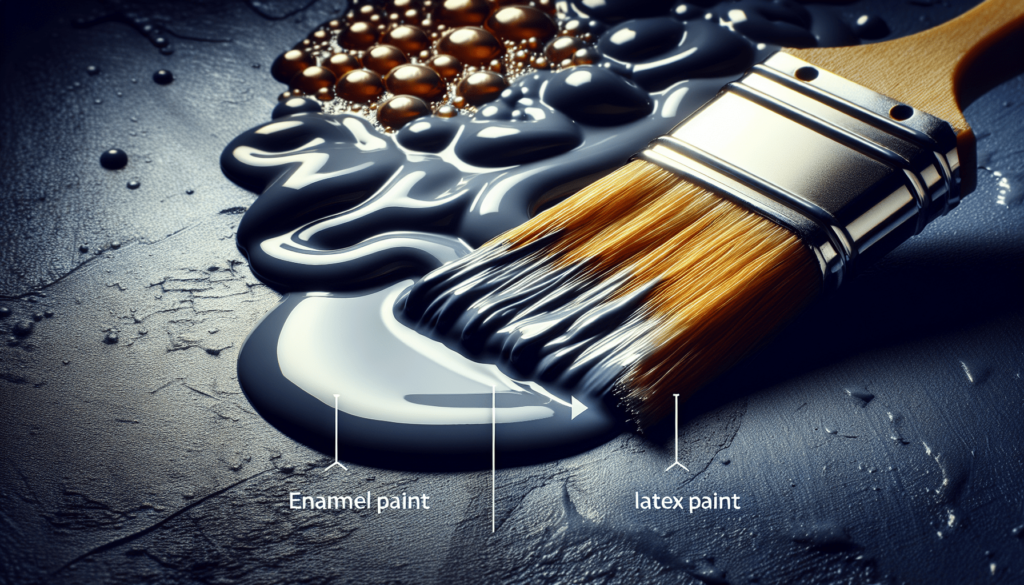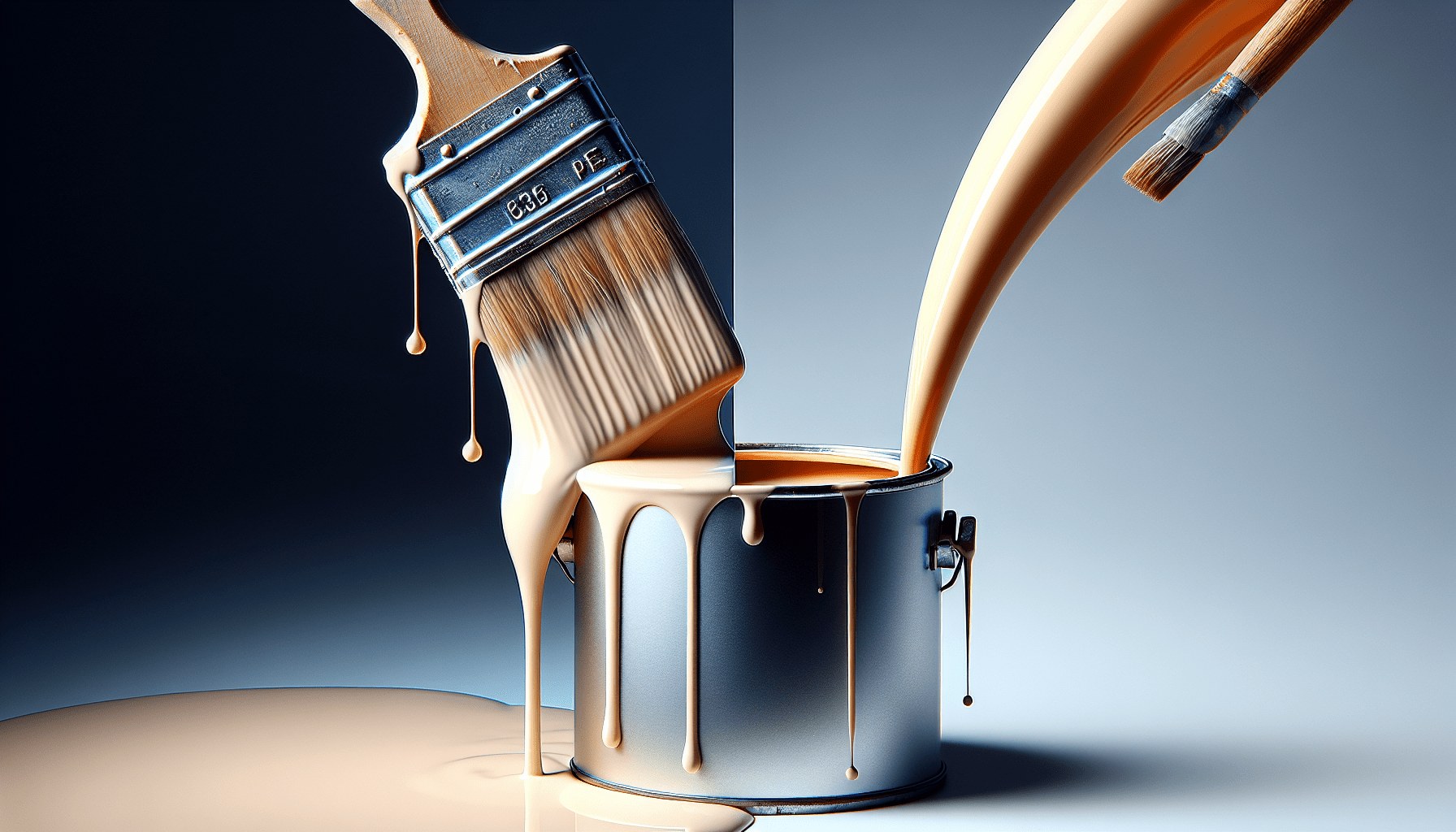Enamel paint is a commonly used type of paint known for its durability and high-gloss finish. However, there is often confusion surrounding whether enamel paint is considered latex or not. In this article, we will clarify the distinction between enamel paint and latex paint, providing you with a clear understanding of their differences and similarities. By exploring the composition and applications of enamel paint, you will gain valuable insights to inform your painting projects and ensure the best results.

Is Enamel Paint Latex
Enamel paint and latex paint are two popular options when it comes to choosing the right type of paint for your project. While both may have specific qualities and advantages, they are not the same. In this article, we will define enamel paint and latex paint, discuss their characteristics, highlight their key differences, explore their common uses, and examine whether enamel paint can be latex-based.
Definition of Enamel Paint
Enamel paint is a type of paint that is known for its hard, durable finish. It consists of a pigment suspended in an oil-based formulation, typically made with alkyd resin or linseed oil. The oil-based nature of enamel paint gives it a thicker and glossier appearance compared to other types of paint. It is often used for surfaces that require high durability and protection, such as metal, wood trim, and cabinets.
Definition of Latex Paint
Latex paint, also known as acrylic paint, is a water-based paint that consists of pigments suspended in a latex or acrylic polymer emulsion. Unlike enamel paint, latex paint has a quick drying time and a lower odor. It is easy to clean up with soap and water, making it a convenient choice for interior projects. Latex paint is commonly used on walls, ceilings, and other interior surfaces that require a flexible and breathable coating.
Difference between Enamel Paint and Latex Paint
The main difference between enamel paint and latex paint lies in their formulation, durability, application, drying time, maintenance and clean-up, suitability for different surfaces, odor, environmental impact, and cost. Let’s explore each of these differences in detail.
Characteristics of Enamel Paint
Oil-based Formulation
Enamel paint is formulated with oil-based ingredients such as alkyd resin or linseed oil. This gives it a thicker consistency and allows it to provide a more durable finish compared to latex paint. The oil-based formulation also contributes to its glossier appearance.
Hard, Durable Finish
Enamel paint is known for its hard and durable finish. It forms a protective coat that resists scratches, stains, and moisture. This makes it suitable for high-traffic areas such as floors and furniture where durability is a priority.
Thicker and Glossier Appearance
Due to its oil-based formulation, enamel paint has a thicker consistency and a glossier appearance. This can enhance the aesthetics of surfaces, giving them a smooth and shiny finish.
Longer Drying Time
One characteristic of enamel paint is its longer drying time compared to latex paint. This can be beneficial in certain situations, allowing for better leveling and reduced brush or roller marks. However, it also means that the painted surface needs to be protected from dust or contact until it fully dries.
Provides Good Protection
Enamel paint provides excellent protection against moisture, wear, and other forms of damage. This makes it an ideal choice for surfaces that are exposed to harsh environments or frequent use.
Suitable for High-traffic Areas
Due to its durability and protective qualities, enamel paint is often used in high-traffic areas such as hallways, stairs, and door frames. It can withstand heavy use and maintain its appearance over time.
Characteristics of Latex Paint
Water-based Formulation
Unlike enamel paint, latex paint is formulated with a water-based emulsion of latex or acrylic polymers. This makes it easy to clean up with water and creates a paint that is less toxic and has a lower odor compared to oil-based paints.
Quick Drying
One of the key characteristics of latex paint is its quick drying time. This allows for faster completion of painting projects and minimizes the risk of dust or debris adhering to the painted surface.
Lower Odor
Due to its water-based formulation, latex paint has a lower odor compared to enamel paint. This makes it a more comfortable option for interior painting projects, especially in confined spaces.
Easy Clean-up
Latex paint is easy to clean up with soap and water, making it a convenient choice for both professionals and DIY painters. Brushes, rollers, and other tools can be cleaned easily without the need for strong solvents or chemicals.
Flexible and Breathable
Another advantage of latex paint is its flexibility and breathability. It allows moisture to escape from the painted surface, reducing the risk of mold or mildew growth. This makes latex paint suitable for areas with fluctuating humidity levels, such as bathrooms or kitchens.
Suitable for Interior Use
Latex paint is primarily used for interior applications such as walls, ceilings, and other interior surfaces. Its ease of use, quick drying time, low odor, and flexible properties make it a popular choice for residential and commercial projects.

Key Differences between Enamel Paint and Latex Paint
Formulation
Enamel paint is formulated with oil-based ingredients, while latex paint is formulated with water-based latex or acrylic polymers.
Durability and Finish
Enamel paint provides a hard, durable finish and is highly resistant to stains, scratches, and moisture. Latex paint, although not as durable as enamel paint, offers good protection and flexibility.
Application
Enamel paint is typically applied with a brush or roller, while latex paint can be applied with various tools including brushes, rollers, or even sprayers.
Drying Time
Enamel paint takes longer to dry compared to latex paint. This can be an advantage for better leveling and reduced brush or roller marks, but it requires more patience during the painting process.
Maintenance and Clean-up
Enamel paint may require more diligence and stronger solvents for clean-up, while latex paint can be easily cleaned up with soap and water. Latex paint also requires less maintenance over time.
Suitability for Different Surfaces
Enamel paint is commonly used on metal surfaces, wood trim, cabinets, and furniture. Latex paint is primarily used on walls, ceilings, and other interior surfaces.
Odor
Enamel paint has a stronger odor due to its oil-based formulation, while latex paint has a lower odor thanks to its water-based formulation.
Environmental Impact
Enamel paint contains volatile organic compounds (VOCs) that contribute to air pollution and can have harmful effects on human health. Latex paint, on the other hand, has lower levels of VOCs and is more environmentally friendly.
Cost
Enamel paint is generally more expensive than latex paint due to its formulation and durability. Latex paint is a more cost-effective option for most painting projects.
Common Uses of Enamel Paint
Metal Surfaces
Enamel paint is commonly used on metal surfaces due to its durability and ability to withstand exposure to harsh environments. It can provide protection against rust, corrosion, and weathering.
Wood Trim and Doors
Enamel paint is often used on wood trim and doors to provide a long-lasting finish and enhance their aesthetics. It can resist wear and tear from daily use and maintain its appearance over time.
Cabinets and Furniture
Enamel paint is a popular choice for cabinets and furniture, as it offers a hard and durable finish that can withstand frequent use. It provides a smooth and glossy appearance, enhancing the overall look of the surfaces.
Bathrooms and Kitchens
The moisture-resistant properties of enamel paint make it suitable for bathrooms and kitchens, where high humidity levels and exposure to water are common. It can protect surfaces from moisture damage and maintain its appearance in these areas.
Common Uses of Latex Paint
Walls and Ceilings
Latex paint is extensively used on walls and ceilings due to its ease of application, quick drying time, and versatility in terms of color options. It provides a durable and washable finish that can withstand daily wear and tear.
Interiors of Homes and Offices
Latex paint is a popular choice for interior spaces in both residential and commercial buildings. It can transform the look and feel of a room, while its low odor and easy clean-up make it suitable for occupied spaces.
Children’s Rooms
Latex paint is a safe choice for children’s rooms due to its lower levels of VOCs and minimal odor. It allows for quick and easy clean-up, making it ideal for spaces that are prone to messes or frequent changes.
Other Interior Surfaces
Latex paint can be used on various other interior surfaces such as doors, trim, baseboards, and furniture. Its flexibility and breathability make it suitable for areas that require a protective yet breathable coating.
Can Enamel Paint Be Latex-based?
While enamel paint is traditionally formulated with oil-based ingredients, there are specialized formulations available that imitate the characteristics of enamel paint using latex or acrylic polymers. These latex-based enamel paints aim to provide a similar hard and durable finish while offering the convenience of water-based clean-up and lower levels of VOCs. However, it is important to note that true enamel paint is oil-based, and the use of a latex-based enamel paint should be properly researched and tested before use.
Benefits of Using Enamel Paint
Excellent Durability
Enamel paint is known for its outstanding durability. It can withstand heavy use, resist stains and moisture, and maintain its appearance over time. This makes it a reliable choice for surfaces that require long-lasting protection.
High Gloss and Vibrant Color
Enamel paint offers a high gloss and vibrant color, providing surfaces with a rich and attractive finish. It can enhance the aesthetics of any project, adding depth and shine to the painted surfaces.
Good Protection against Moisture and Wear
Enamel paint provides a robust barrier against moisture, wear, and various forms of damage. It can protect surfaces from rust, scratches, and stains, ensuring longevity and maintaining the integrity of the painted areas.
Benefits of Using Latex Paint
Quick Dry Time
One of the major advantages of latex paint is its quick drying time. This allows for faster completion of painting projects and reduces the risk of smudges, dust, or debris adhering to the painted surface.
Easy Clean-up
Latex paint can be easily cleaned up with soap and water. Brushes, rollers, and other tools can be rinsed off quickly, making the clean-up process efficient and hassle-free. This saves valuable time and effort, especially for larger projects.
Minimal Odor
Latex paint has a lower odor compared to oil-based paints, making it more comfortable to work with, especially in indoor settings. It eliminates the need for strong solvents or ventilation, creating a more pleasant painting experience.
Conclusion
In conclusion, enamel paint and latex paint serve different purposes based on their formulation, characteristics, and intended uses. Enamel paint, with its oil-based formulation, provides a hard and durable finish, making it suitable for high-traffic areas and surfaces that require maximum protection. On the other hand, latex paint, with its water-based formulation, offers quick drying time, easy clean-up, and minimal odor, making it a convenient and versatile choice for interior projects. When selecting between enamel paint and latex paint, consider the specific requirements of your project, the desired finish, and the surfaces you will be painting. By understanding the differences and benefits of each type of paint, you can make an informed decision and achieve the best results for your painting endeavor.



